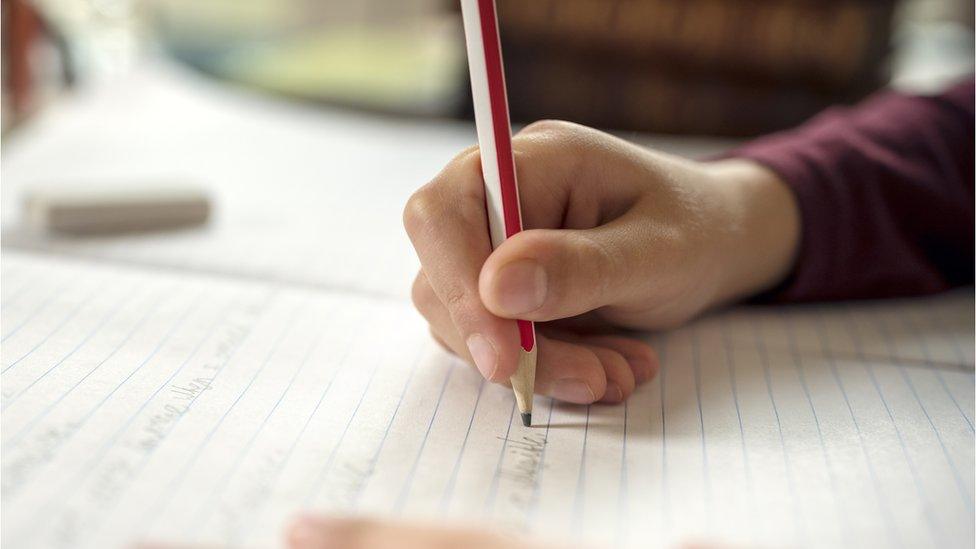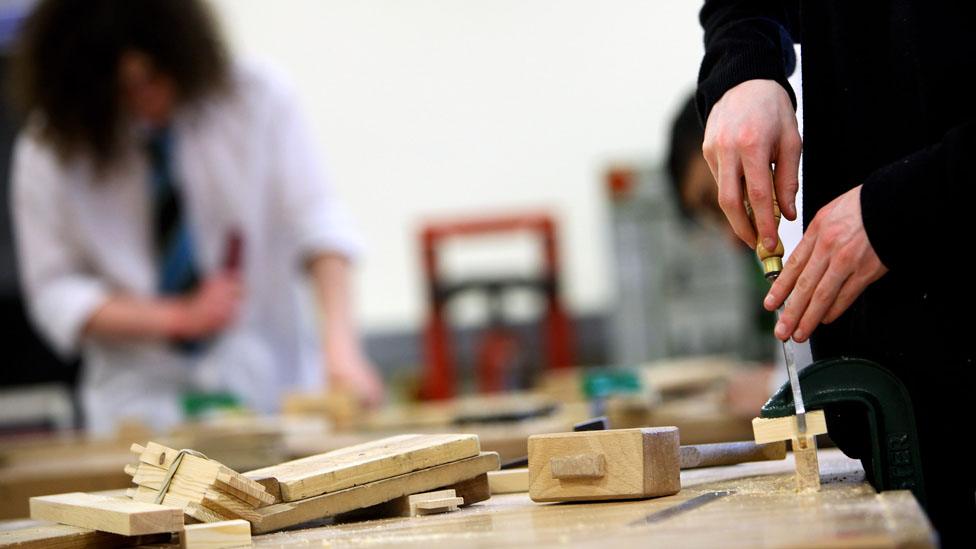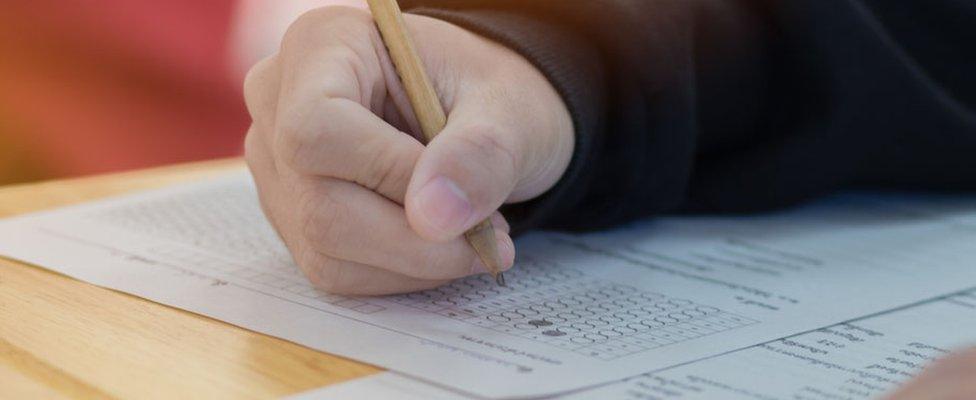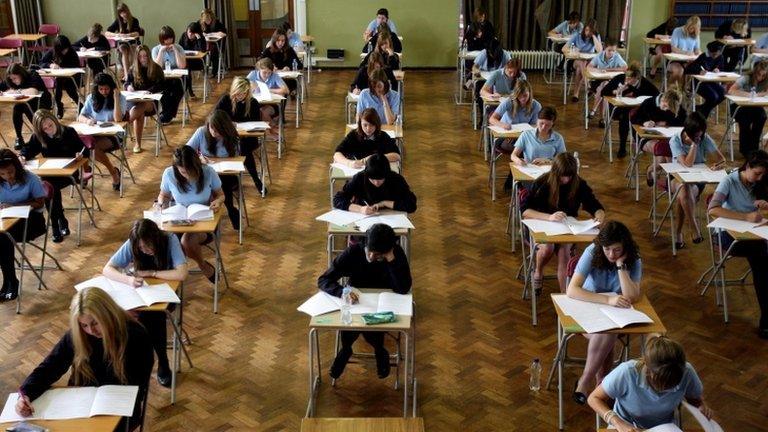Fears over fall in number of courses offered in Scottish schools
- Published

Reform Scotland research shows only a minority of state schools now allow pupils to sit more than six exams
State schools in Scotland are cutting the number of exams pupils are allowed to sit, according to new research.
Reform Scotland says the number of National 4 and 5 courses which schoolchildren can take has reduced in recent years.
The situation has been described as the "unintended consequence" of Curriculum for Excellence (CfE) by critics.
The Scottish government insisted it is the qualifications which pupils leave school with that matter the most.
The Reform Scotland research, based on a series of freedom of information requests, found a "minority" of Scottish schools allow pupils to sit more than six National 4 and 5s, with some only offering five subjects.
This contrasts with the previous Standard Grade system where most schools allowed pupils to take seven or eight subjects.

The research found there are often variations in the number of exams allowed to be taken across schools within the same council areas
Keir Bloomer, one of the architects of the CfE teaching programme introduced to Scotland's schools in 2010, said: "One of the purposes of CfE was to broaden pupils' education, but instead the way in which it is being implemented is narrowing it significantly.
"There is ample opportunity for pupils to combine practical and academic options when they are enabled to sit nine, eight, or even seven exams, but when we narrow it down to six or five there is very little room for manoeuvre."
Mr Bloomer, a former local authority director of education and chairman of a Reform Scotland commission on school reform, added: "Reducing the number of subject options is not a government policy.
"It has come about by accident; the unintended consequence of ill-conceived advice. This is the hallmark of poor management.
"This is a lose-lose."

The National 4 and 5 qualifications took the place of Standard Grades in 2014
Freedom of Information requests by Reform Scotland revealed that in 2016, all schools in Edinburgh, East Dunbartonshire and Dumfries and Galloway offered eight exams.
Now no schools in either East Dunbartonshire or Dumfries and Galloway offer eight, and the limit in Edinburgh varies between six and eight, according to the research.
The think tank contrasts this with Scotland's private schools where pupils are typically given the opportunity to take eight or nine National 4 or 5 qualifications.
'Unintended consequences'
Chris Deerin, director of Reform Scotland, claimed children whose parents can afford to send them to private school or move within another school's catchment area will be unaffected by what he described as the "unintended consequence of the Curriculum for Excellence".
He added: "We are in real danger of opening up a new type of attainment gap in Scotland - one where children who are allowed to sit eight or nine National 4s or 5s will have a distinct advantage over those restricted to five or six, regardless of the latter's ability.
"The schools cutting the number of exams on offer are typically those serving our more deprived communities, further limiting the life opportunities of children who may already be disadvantaged."
The Scottish Conservatives' education spokesperson, Liz Smith MSP, said it was a "disgrace" that most students only had the chance to do six subjects in S4.

A Scottish government spokeswoman defended CfE, claiming it "provides significant flexibility" and allows schools to "have the freedom to design a bespoke three-year senior phase of a range of courses and qualifications tailored to meet the needs of the young people at the school".
She added: "What matters is the qualifications and awards that pupils leave school with, and not only what they study in S4.
"Almost two-thirds now leave school in S6, and last year a record proportion went on to positive destinations including work, training or further study.
"Young people also now have opportunities to study towards a much broader range of qualifications, not just at school, but also at college and through apprenticeships."

Does the exam system restrict choice?
Analysis by Jamie McIvor, BBC Scotland education correspondent

It is no surprise that different schools use the new qualifications in different ways.
That was an intentional part of the new qualifications system, and individual schools and councils took decisions on what they believed was right for their local circumstances.
The most popular curricular model allows students to obtain up to six qualifications in S4.
However, a significant number of schools offer seven - while smaller numbers offer five, eight or even routinely avoid presenting candidates for qualifications in S4.
Top level
There are legitimate arguments for and against each of the models - but does it place some youngsters at an advantage over others?
The emphasis is now on the qualifications a young person has obtained by the time they leave school - not on what they have achieved by the end of a particular year.
The emphasis is also on a student's top level of performance in each subject, rather than the total number of qualifications they gain.
It is now unusual to leave school in S4, and most stay on until S6 - not just the so-called "academic elite".

In that sense, if a student gets a Higher in a subject in S5, the National 5 they obtained in S4 might be seen as having been unnecessary for some - but a useful step on the way to a Higher for another.
However, there are some longstanding concerns.
Some parents fear that unless a child can do at least seven qualifications in S4 they are, in effect, having to pick their Highers a year early.
Qualifications system
Some have warned that some subjects - including art and modern languages - are being squeezed out in S4 so choice is being restricted.
It is argued that time constraints led to some schools offering six qualifications in S4 - rather than a belief that this was the best possible model.
And while colleges and universities understand how the qualifications system operates, might some employers fail to realise that some young people had different opportunities to obtain S4 qualifications?
That might be a particularly pertinent point for young people who are less academically able - their National 4s or 5s are more likely to represent their top achievement in a subject.
But is the argument then for a degree of national standardisation? Or just to ensure that the system is understood?
- Published15 April 2014
